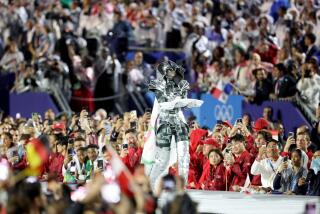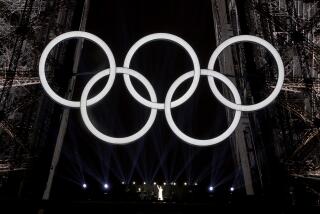Controversial New Pyramid Entrance to the Louvre Opens in Paris
PARIS — There were plenty of pre-birth jitters and confusion Wednesday under the controversial new glass pyramid at the Louvre Museum.
As repair crews and cleaners made last-minute patrols through the acres of gleaming underground marble topped by the jutting 70-foot glass peak, distinguished American architect Ieoh Ming Pei was seen appealing to a museum guard to let him into a roped-off area of the new building.
“But I am the architect,” argued Pei, fumbling with his wallet in search of identification.
Pei was eventually rescued by a blushing museum official. But he remained as nervous as an expectant father until his friend and admirer, French President Francois Mitterrand, formally inaugurated the impressive $300-million new addition to the museum Wednesday afternoon in a simple and elegant ceremony.
After the ribbon-cutting, an enthusiastic crowd of tourists and onlookers were allowed to stream in, lending a spontaneous, populist feel to the grand opening of the structure that has been the focus of a lively French aesthetic and political debate for more than five years.
I. M. Pei beamed. “You are never sure about these things until they are built,” he said. As the architect spoke, a wash of brilliant sunlight poured in through the crystal-clear roof--793 panes of glass specially made from the pure white sand of a quarry in Fontainebleau.
Beginning Friday, the 650,000-square-foot new addition will serve as the entrance and reception area for the famous museum--home of the Mona Lisa, the Venus de Milo, Winged Victory of Samothrace and many other great works of art.
American visitors (there were more than 300,000 last year) will be especially happy to know that the new addition will include toilets, restaurants and multilingual information booths conspicuously lacking in the old museum and, indeed, in many other French museums.
Whether this will help the tourists in their traditional quest to find the Mona Lisa and other major works remains to be seen. The new color-coded orientation guide released last week seemed not much more illuminating than the confusing old model.
However, with spacious restaurants, cafes, cloakrooms, bathrooms and even separate lecture rooms for group tours, visitors will at least be more comfortable than before during their art hunt.
Most visitors to the museum will now enter through a door in the glass pyramid, situated in the central Napoleon Courtyard of the giant, horseshoe-shaped former palace.
Descending on escalators or a dramatic spiral staircase, the visitors arrive at a reception floor with information booths, banks of television screens, a 400-seat auditorium, a large restaurant, a cafe and the main bookstore.
From the reception area, more escalators lead to the three separate wings of the reoriented museum. In digging up the courtyard to install the underground complex, the builders unearthed the ancient ramparts of the early palaces and forts on the site, which have been kept as an archeological display.
There is also an impressive new exhibit detailing the history of the museum from its days as a medieval fort to its modern vision, inspired by Mitterrand, to become the Grand Louvre, one of the world’s largest and most technologically advanced art museums, by 1993.
The Mitterrand government has dedicated nearly $1 billion to this dream, which, along with the construction of the new Bastille Opera and a giant new national library, is seen as the president’s personal, monumental legacy, in much the same way that the Arch of Triumph represented Napoleon I and the modernistic Pompidou Center reflects the rule of the late President Georges Pompidou.
On a warm, bright afternoon that showed off his monument in jewel-like glory, Mitterrand was clearly happy. For the president, the museum and its controversial glass ornament had become a challenge not only to his government but, even more important in French eyes, to his good taste.
Architectural critics mocked the design as “an annex to Disneyland.” A Cabinet minister refused to move out of the building to make room for the new project. When construction workers made too much noise, the minister had them cited.
“This has been a very difficult birth, a sale histoire (dirty episode),” said an aide to French Minister of Culture Jack Lang. “But on a day like this, it all seems worth it.” After all, the political problems were solved last summer by the defeat of the conservative government of Premier Jacques Chirac.
The finance minister who was reluctant to move from his wing of the Louvre was forced out by the voters. Lang, a Mitterrand favorite, was reinstalled as culture minister to supervise the new building.
Museum Director Michel Laclotte declared himself happy with the results. “I have always been a partisan to this design,” Laclotte said. “The pyramid is not a gadget. The reason for the pyramid is to bring light inside.”
More to Read
Sign up for Essential California
The most important California stories and recommendations in your inbox every morning.
You may occasionally receive promotional content from the Los Angeles Times.










